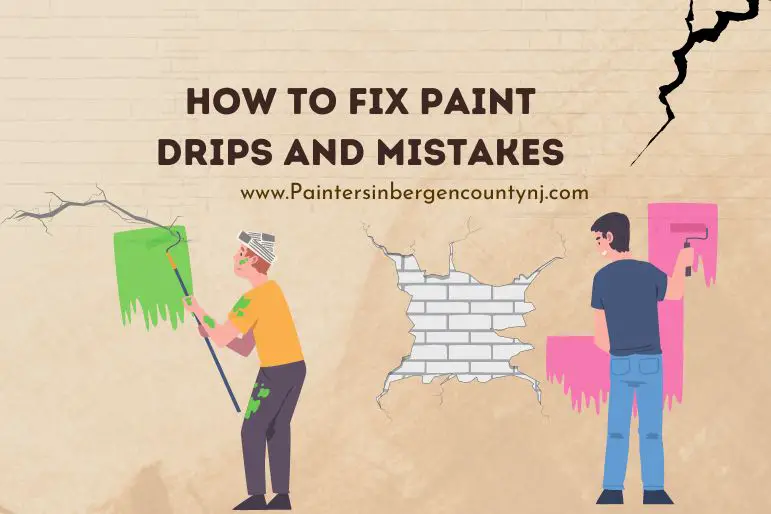Painting is a very popular and effective home improvement project to change the appearance and atmosphere of a space. However, even experienced painters can encounter paint drips and mistakes that mar the overall finish. This comprehensive guide will explore various methods and strategies to help you fix paint drips, correct painting mistakes, and achieve a seamless finish. Let’s dive in and discover the secrets to fixing paint drips and mistakes like a pro.
Section 1: Understanding Paint Drips and How to Fix Them
Identifying Paint Drips and Their Causes
Paint drips typically happen due to the following:
- Excess paint
- Painting too slowly
- Gravity
- Thick paint consistency
Step-by-Step Guide to Fixing Paint Drips
Step 1: Addressing Wet Paint Drips
- Use a damp cloth to remove the excess paint.
- Feather the edges of the affected area.
- Let the paint dry completely.
Step 2: Correcting Dry Paint Drips
- Lightly sand the dried paint and drip until smooth.
- Wipe away sanding dust.
- Touch up with paint, blending seamlessly.
- Allow the paint to dry completely.
Section 2: Strategies for Correcting Painting Mistakes
Addressing Brush Strokes and Uneven Coverage
- Sand the affected area until smooth.
- Wipe away sanding dust.
- Apply a light coat of paint.
- Allow the paint to dry completely.
Fixing Paint Chips, Wrinkled Paint, and Raised Edges
Fixing Paint Chips:
- Gently scrape away loose or raised paint chips.
- Lightly sand the area around the chip.
- To prepare the area, please clean it and then apply a thin layer of primer.
- Touch up the chip with matching paint.
- Allow the paint to dry completely.
Addressing Wrinkled Paint:
- Gently scrape away the affected area.
- Sand the area lightly.
- Wipe away sanding dust.
- Apply a thin coat of primer.
- Apply a new coat of paint.
- Allow the paint to dry completely.
Correcting Raised Edges:
- Gently sand down the raised edges until level.
- Wipe away sanding dust.
- Apply a touch-up coat of paint.
- Allow the paint to dry completely.
Section 3: Additional Tips for a Perfect Paint Finish
Proper Paint Application Techniques
- Use a high-quality paint roller or brush.
- Work in small sections, maintaining a wet edge.
- Apply the paint in smooth, even strokes.
- Use a small brush for precision areas.
Best Practices to Avoid Common Painting Mistakes
- Thoroughly clean the surface before painting.
- Use painter’s tape to protect areas.
- Stir the paint thoroughly before application.
- Apply the paint in thin, light coats.
Ensuring Proper Drying and Finishing Touches
- Allow the paint to dry completely between coats.
- Inspect the surface for imperfections or touch-ups needed.
- Apply necessary touch-ups, ensuring seamless blending.
- Clean brushes and rollers thoroughly after each use.
Terms to Learn About Painting:
Too Much Paint
To avoid negative outcomes when painting, it’s important to not use too much paint. Excessive paint can cause drips, an uneven finish, and visible brush strokes. If you apply the paint too thick, it may not spread evenly and may settle in low areas or crevices, making it look unsightly.
Paint Scraper
A paint scraper is a useful tool for fixing wet or dry paint drips. If the drips are still wet, use the scraper to gently remove excess paint while blending the edges to prevent damage to the surface. For dried drips, use the scraper to smooth the area before applying a touch-up coat of paint.
Razor Blade
To remove excess paint, you can use a razor blade as a tool. Be sure to exercise caution when scraping off wet or dry paint drips so that the surface contours are preserved while the edges are feathered. Using a clean razor is crucial to avoid causing additional harm to the surface.
Second Coat
For a smooth and protective finish, wait until the first coat of paint has completely dried before applying a second coat. Be sure to allow each coat to dry thoroughly before adding another layer. This will help the paint adhere properly and avoid any damage caused by external factors such as scratches or chips.
Sanding Block
For a smooth and polished finish when painting, use a sanding block with a fine-grit texture. Doing so will prevent any damage to the surface while removing any imperfections and help create a seamless blend between layers of paint, ultimately eliminating visible brush strokes.
Dreaded Paint Drip
Don’t worry if you have paint drips when painting; it’s a common problem that can be fixed. To avoid them, when painting walls or ceilings, try to move the roller in one direction only and apply lighter pressure near the edges. In case paint droplets form on the surface, use a scraper or razor blade to remove them carefully while blending the edges. If needed, after removing the drips, add a touch-up coat of paint. Always wait for each coat to dry completely before applying the next one.
Conclusion
In conclusion, fixing paint drips and mistakes is crucial for achieving a flawless paint job. This guide outlines techniques and strategies to address common issues, including paint drips, uneven coverage, brush strokes, and more. By following these, you can improve your painting skills. Remember to work with patience, attention to detail, and proper drying time between coats. With practice and the right approach, you can become proficient at fixing paint drips and achieving flawless finishes.
Remember, painting is both an art and a skill that improves with experience. Embrace mistakes as learning opportunities. If you follow the tips and techniques explained in this guide, you’ll be able to paint like a professional and improve your skills.
References
https://www.bobvila.com/slideshow/17-easy-fixes-for-a-botched-paint-job-49719
https://diydivapro.com/the-complete-guide-to-fixing-paint-drips/

